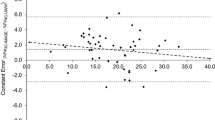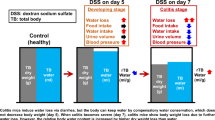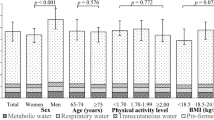Abstract
Objective:
To investigate the variability in isotopic equilibrium time under field conditions, and the impact of this variability on estimates of total body water (TBW) and body composition.
Design and Setting:
Following collection of a fasting baseline urine sample, 10 women and 10 men were dosed with deuterium oxide (0.05 g/kg body weight). Urine samples were collected every hour for 8 h. The samples were analysed using isotope ratio mass spectrometry. Time to equilibration was determined using three commonly employed data analysis approaches.
Results:
Isotopic equilibrium was reached by 50, 80 and 100% of participants at 4, 6 and 8 h, respectively. The mean group equilibration determined using the three different plateau determination methods were 4.8±1.5, 3.8±0.8 and 4.9±1.4 h. Isotopic enrichment, TBW, and percent body fat estimates differed between early (3–5 h), but not later sampling times (5–8 h).
Conclusion:
Although the three different plateau determination approaches resulted in differences in equilibration time, all suggest that sampling at 6 h or later will decrease the likelihood of error in body composition estimates resultant from incomplete isotopic equilibration in a small proportion of individuals.
This is a preview of subscription content, access via your institution
Access options
Subscribe to this journal
Receive 12 print issues and online access
$259.00 per year
only $21.58 per issue
Buy this article
- Purchase on SpringerLink
- Instant access to full article PDF
Prices may be subject to local taxes which are calculated during checkout



Similar content being viewed by others
References
Bauer J, Capra S, Davies PSW (2005). Estimation of total body water from foot-to-foot bioelectrical impedance analysis in patients with cancer cachexia - agreement between three prediction methods and deuterium oxide dilution. J Hum Nutr Dietet 18, 295–300.
Blanc S, Colligan AS, Trabulsi J, Harris T, Everhart JE, Bauer D et al. (2002). Influence of delayed isotopic equilibration in urine on the accuracy of the 2H218O method in the elderly. J Appl Physiol 92, 1036–1044.
Drews D, Stein TP (1992). Effect of bolus fluid intake on energy expenditure values as determined by the doubly labeled water method. J Appl Physiol 72, 82–86.
Fjeld CR, Brown KH, Schoeller D (1988). Validation of the deuterium oxide method for measuring average daily milk intake in infants. Am J Clin Nutr 48, 671–679.
Halliday D, Miller AG (1977). Precise measurement of total body water using trace quantities of deuterium oxide. Biomed Mass Spectrom 4, 82–87.
Isenring E, Bauer J, Capra S, Davies PSW (2004). Evaluation of foot-to-foot bioelectrical impedance analysis for the prediction of total body water in oncology outpatients receiving radiotherapy. Eur J Clin Nutr 58, 46–51.
Jankowski CM, Sonko BJ, Gozansky WS, Kohrt WM (2004). Deuterium dilution: the time course of 2 H enrichment in saliva, urine, and serum. Clin Chem 50, 1699–1701.
Lukaski HC, Johnson PE (1985). A simple, inexpensive method of determining total body water using a tracer dose of D2O and infrared absorption of biological fluids. Am J Clin Nutr 41, 363–370.
McMurrey JD, Boling EA, Davis JM, Parker HV, Magnus IC, Ball MR et al. (1958). Body composition: simultaneous determination of several aspects by the dilution principle. Metabolism 7, 651.
Mendez J, Prokop E, Picon-Reategui E, Akers R, Buskirk ER (1970). Total body water by D2O dilution using saliva samples and gas chromatography. J Appl Physiol 28, 354–357.
Puiman PJ, Francis P, Buntain H, Wainwright, Masters B, Davies PSW (2004). Total body water in children with cystic fibrosis using bioelectrical impedance. J Cystic Fibrosis 3, 243–247.
Racette SB, Schoeller D, Luke A, Shay K, Hnilicka J, Kushner RF (1994). Relative dilution spaces of 2H- and 18O-labeled water in humans. Am J Physiol 267 (Endocrinology and Metabolism 30), E585–E590.
Raman A, Schoeller DA, Subar AF, Troiano RP, Schatzkin A, Harris T et al. (2004). Water turnover in 458 American adults 40–79 yr of age. Am J Physiol Renal Physiol 286, F394–F401.
Rush EC, Plank LD, Davies PSW, Watson P, Wall CR (2003). Body composition and physical activity in New Zealand Maori, Pacific and European children aged 5–14 years. Brit J Nutr 90, 1133–1139.
Salazar G, Infante C, Vio F (1994). Deuterium equilibration time in infant's body water. Eur J Clin Nutr 48, 475–481.
Schloerb PR, Friis-Hansen BJ, Edelman IS, Solomon AK, Moore FD (1950). The measurement of total body water in the human subject by deuterium oxide dilution; with a consideration of the dynamics of deuterium distribution. J Clin Invest 29, 1296–1310.
Schoeller D (1996). Hydrometry. Human Body Composition. Champaign, IL: Human Kinetics, 25–44.
Schoeller D, Colligan A, Shriver T, Avak H, Bartok-Olson C (2000). Use of an automated chromium reduction system for hydrogen isotope ratio analysis of physiological fluids applied to doubly labeled water analysis. J Mass Spectrom 35, 1128–1132.
Schoeller D, Dietz W, van Santen E, Klein PD (1982). Validation of saliva sampling for total body water determination by H218O dilution. Am J Clin Nutr 35, 591–594.
Schoeller D, van Santen E, Peterson DW, Dietz W, Jaspan J, Klein PD (1980). Total body water measurement in humans with 18O and 2 H labeled water. Am J Clin Nutr 33, 2686–2693.
Smith D, Engel B, Diskin AM, Spanel P, Davies SJ (2002). Comparative measurements of total body water in healthy volunteers by online breath deuterium measurement and other near-subject methods. Am J Clin Nutr 76, 1295–1301.
Speakman JR (1997). Doubly Labelled Water: Theory and Practice. London;New York, Chapman & Hall.
van Marken Lichtenbelt W, Westerterp K, Wouters LJM (1994). Deuterium dilution as a method for determining total body water: effect of test protocol and sampling time. Br J Nutr 72, 491–497.
Wong WW (2003). Body composition measurements with 2 H and 18O isotope dilution. Stable Isotopes in Human Nutrition-Laboratory Methods and Research Applications In: Abrams SA, Wong WW (eds). New York: CABI Publishing, 107–126.
Wong WW, Butte NF, Smith EOB, Garza C, Klein PD (1989). Body composition of lactating women determined by anthropometry and deuterium dilution. Br J Nutr 61, 25–33.
Wong WW, Cochran WJ, Klish WJ, Smith EOB, Lee LS, Klein PD (1988). In vivo isotope-fractionation factors and the measurement of deuterium- and oxygen-18-dilution spaces from plasma, urine, saliva, respiratory water vapor, and carbon dioxide. Am J Clin Nutr 47, 1–6.
Acknowledgements
The authors thank Connie Wishart for her laboratory assistance, Scott Wearing for his contribution to data analysis and Ryan van Asten for his assistance in the early phases of data collection.
Author information
Authors and Affiliations
Corresponding author
Additional information
Guarantor: RC Colley.
Contributors: RCC was responsible for the data collection, study design, manuscript writing, data analysis, data interpretation and statistical analysis. NMB initiated the study and was largely involved in the study design, data analysis, data interpretation, statistical analysis and manuscript editing. APH oversaw the initiation and design of the study and manuscript editing.
Rights and permissions
About this article
Cite this article
Colley, R., Byrne, N. & Hills, A. Implications of the variability in time to isotopic equilibrium in the deuterium dilution technique. Eur J Clin Nutr 61, 1250–1255 (2007). https://doi.org/10.1038/sj.ejcn.1602653
Received:
Revised:
Accepted:
Published:
Issue date:
DOI: https://doi.org/10.1038/sj.ejcn.1602653
Keywords
This article is cited by
-
Does metabolic compensation explain the majority of less-than-expected weight loss in obese adults during a short-term severe diet and exercise intervention?
International Journal of Obesity (2012)
-
Pharmacokinetic analysis of absorption, distribution and disappearance of ingested water labeled with D2O in humans
European Journal of Applied Physiology (2012)
-
Measurement of longitudinal changes in body composition during weight loss and maintenance in overweight and obese subjects using air-displacement plethysmography in comparison with the deuterium dilution technique
International Journal of Obesity (2011)



